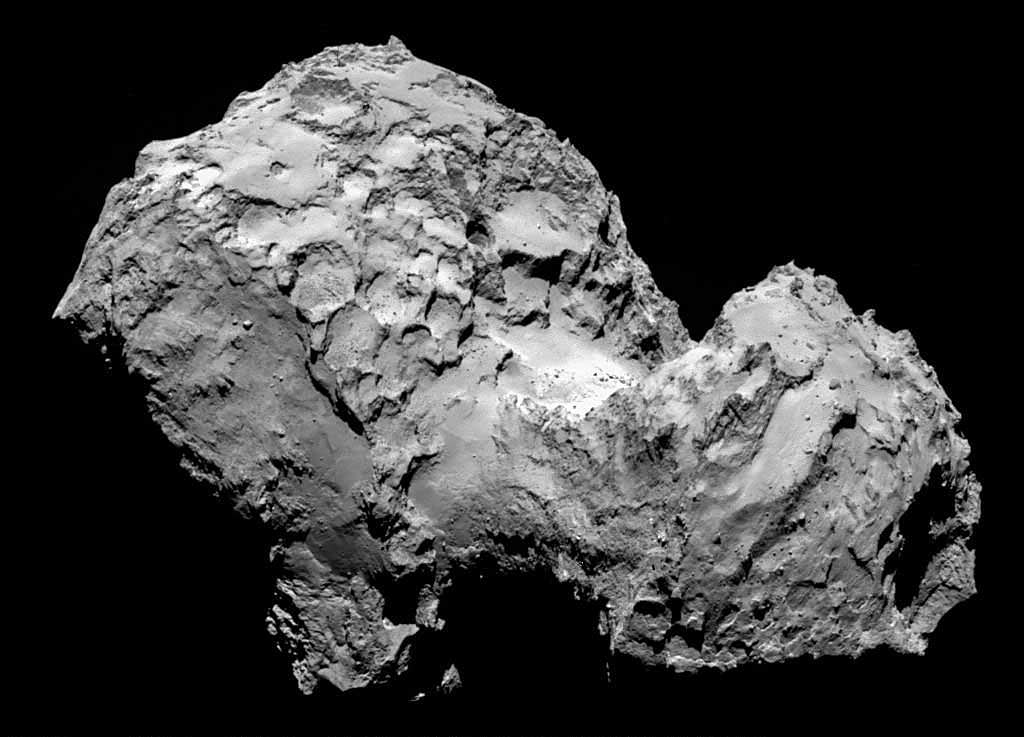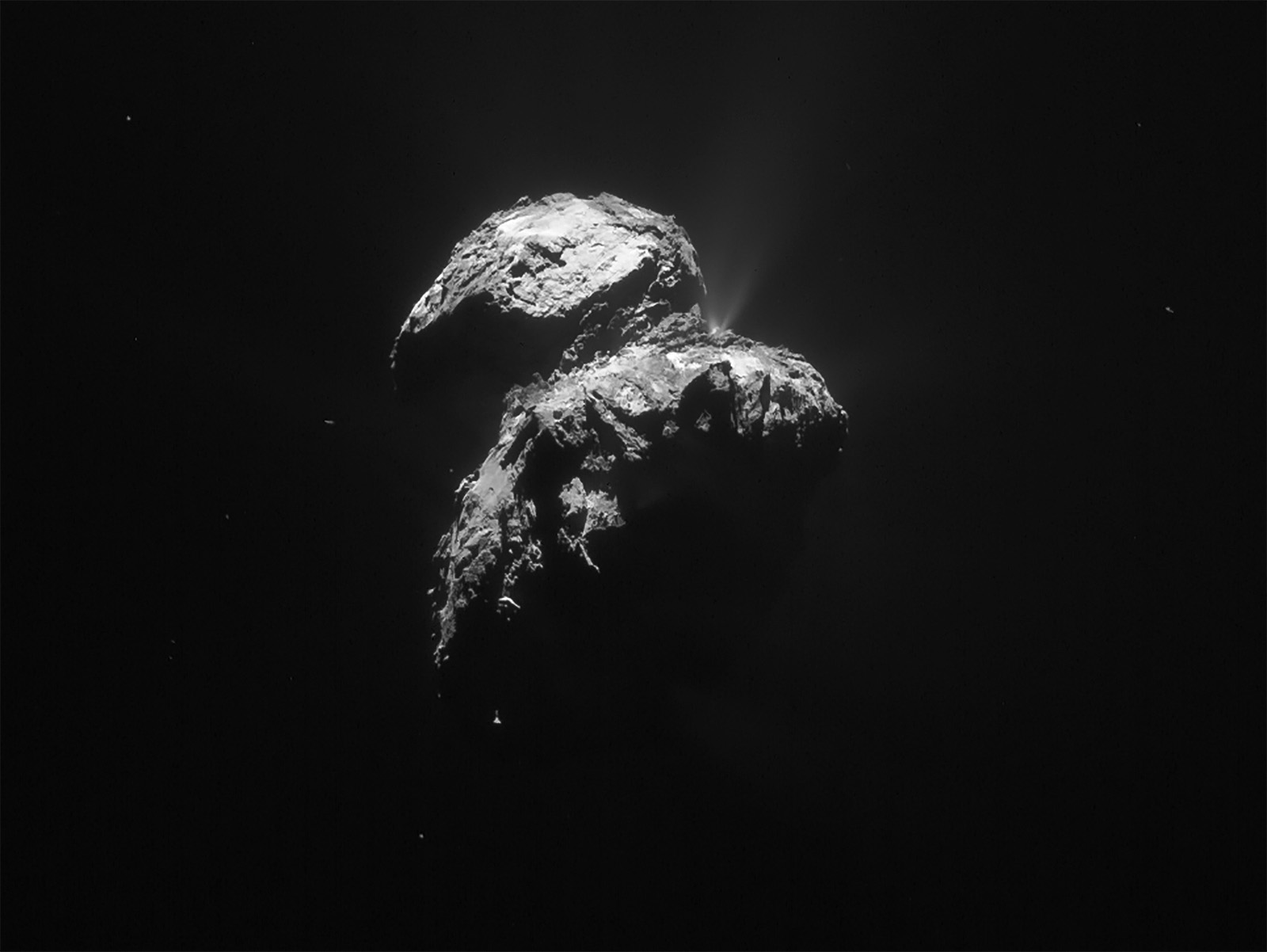Sometimes, space probes that have long since ceased sending back data can still usher in new discoveries. That was the case recently when scientists used data from Rosetta, a probe that eventually crashed into comet 67P/Churyumov-Gerasimenko in 2016, to understand what changes occur on a comet’s surface as it continues its spin around the Sun.
Continue reading “How Long do Good Landing Sites Last on Comets?”Rosetta’s Philae Lander Was Alive on the Surface of 67P for 63 Hours, Trying to Communicate
In August 2014, the ESA’s Rosetta spacecraft arrived at its destination, Comet 67P/Churyumov-Gerasimenko, after a 10 year journey. Rosetta carried a small companion, the Philae Lander. On November 12th, Philae was sent to the surface of Comet 67P. Unfortunately, things didn’t go exactly as planned, and the lander’s mission lasted only 63 hours.
During that time, it gathered what data it could. But mission scientists weren’t certain of its precise location, meaning its data was difficult to interpret accurately. Only when scientists knew precisely where Philae was located on the comet, could they make best use of all of its data.
Continue reading “Rosetta’s Philae Lander Was Alive on the Surface of 67P for 63 Hours, Trying to Communicate”Carnival of Space #468-469
Welcome, come in to the 468th and 469th Carnival of Space – we combined these two since it’s summer break for a lot of folks! The Carnival is a community of space science and astronomy writers and bloggers, who submit their best work each week for your benefit. I’m Susie Murph, part of the team at Universe Today and CosmoQuest. So now, on to this week’s stories!
Continue reading “Carnival of Space #468-469”
Weekly Space Hangout – Feb. 19, 2016: Rebecca Roth
Host: Fraser Cain (@fcain)
Special Guest: Rebecca Roth, Imaging Coordinator & Social Media Specialist at NASA’s Goddard Space Flight Center; responsible for sharing imagery with the media, as well as sharing those images with the public, mainly through social media such as Instagram and Flickr.
Guests:
Morgan Rehnberg (MorganRehnberg.com / @MorganRehnberg )
Kimberly Cartier (@AstroKimCartier )
Dave Dickinson (www.astroguyz.com / @astroguyz)
Jolene Creighton (fromquarkstoquasars.com / @futurism)
Their stories this week:
New X-ray observatory takes to the skies
Hubble Directly Measures Rotation of Cloudy “Super-Jupiter”
Possible Hidden Layer of Meteorites in Antarctica
China to Displace Thousands for New Radio Telescope
Visible light and gravitational waves
We’ve had an abundance of news stories for the past few months, and not enough time to get to them all. So we’ve started a new system. Instead of adding all of the stories to the spreadsheet each week, we are now using a tool called Trello to submit and vote on stories we would like to see covered each week, and then Fraser will be selecting the stories from there. Here is the link to the Trello WSH page (http://bit.ly/WSHVote), which you can see without logging in. If you’d like to vote, just create a login and help us decide what to cover!
We record the Weekly Space Hangout every Friday at 12:00 pm Pacific / 3:00 pm Eastern. You can watch us live on Google+, Universe Today, or the Universe Today YouTube page.
You can also join in the discussion between episodes over at our Weekly Space Hangout Crew group in G+!
Rosetta’s Philae Lander in Permanent Sleep
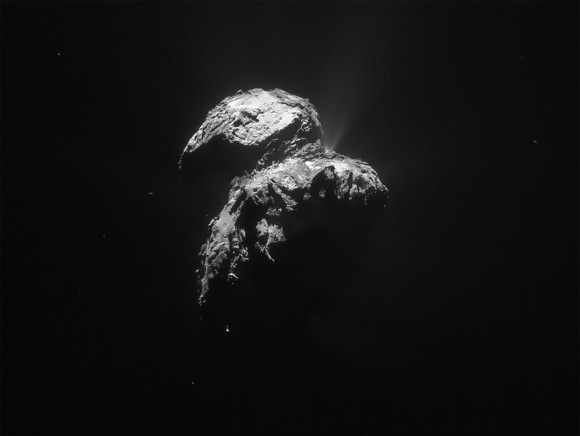
ESA’s Philae lander, the first spacecraft to successfully soft-land on the surface of a comet and former piggyback partner to Rosetta, has not been in communication since July of 2015 and, with 67P now six months past perihelion and heading deeper out into the Solar System, it’s not likely it will ever be heard from again.
Continue reading “Rosetta’s Philae Lander in Permanent Sleep”
Why is it Tough to Land on a Comet?
Why is landing on a comet so difficult and what does this tell us about future missions to comets and asteroids?
Us nerds were riveted by the coverage of the ESA’s Rosetta mission and its arrival at Comet 67/P in 2014. One such nerd is Paco Juarez, friend of the show and patron. He wanted to know why is it so darned hard to land on a comet?
In 2014, the tiny Philae Lander detached from the spacecraft and slowly descended down to the surface of the comet. If everything went well, it would have gracefully touched down and then sent back a pile of information about this filthy roving snowball.
As you know, the landing didn’t go according to plan. Instead of gently touching down on 67/P, Philae bounced off the surface of the comet like a tennis ball dropped from a tower, and rose a kilometer off the surface. Then more descending, and more bouncing, finally settling down on rugged terrain, surrounded by crevices and large boulders. At that point, engineers lost contact with the lander, and so much science went undone.
If I recorded this video a few months ago, that would have been the end of the story. You know how this goes, space exploration is hard and dangerous, don’t be surprised when your missions fail and space unfeelingly smashes up your pretty little robot probes with their little gold foil 27 pieces of flair.
Fortunately, I’m able to report that ESA regained contact with the Philae lander on June 13, 2015, resuming its mission, and scientific operations.
But why is landing on a comet so difficult and what does this tell us about future robotic and human missions to smaller comets and asteroids? When ESA engineers designed Philae, they knew it was going to be very difficult to land on a comet like 67/P because they have a such a low gravity. And they have low gravity because they’re little.
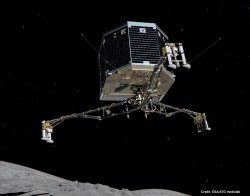
On Earth, 6 septillion tonnes of rock and metal give you an escape velocity of 11.2 km/s. That’s how fast you need to be able to jump in order to leave the planet entirely. But the escape velocity of 67/P is only 1 m/s. You could trip off the comet and never return. Whilst small children threw rocks at you from the surface as you drifted away.
Philae was built with harpoon drills in its landing struts. The moment the lander touched the surface of the comet, those harpoons were supposed to fire, securing the lander. The surface of the comet was softer than scientists had anticipated, and the harpoons didn’t fire. Or possibly they were broken and couldn’t fire. Space is hard. Whatever the case, without being able to grab onto the surface, it used the comet as a bouncy castle.
We’re learning what it takes to land on lower mass objects like comets and asteroids. NASA’s OSIRIS-REx mission will visit Comet Bennu, and send a lander down to the surface of the asteroid. From there it’ll pick up a few samples, and return them back to Earth. It’ll be Philae, all over again.
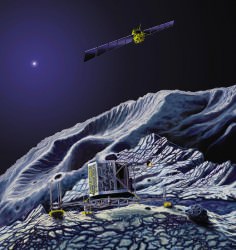
In the future, we’re told, humans will be visiting asteroids to study them for science and their potential for ice and minerals. You can imagine it’ll be a harrowing descent, but even just walking around on the surface will be dangerous when every step could throw an astronaut into an escape trajectory. They’ll need to learn lessons from rock climbers and Rorschach.
As we learned with Philae, landings on low mass objects is really tough. We’re going to need to get more practice and develop new techniques and technologies before we’re ready to add asteroid mining to our list of “stuff we just do, NBD”.
What are some unusual worlds you’d like humanity to visit? Put your suggestions in the comments below.
T-Minus 12 Days to Perihelion, Rosetta’s Comet Up Close and in 3D
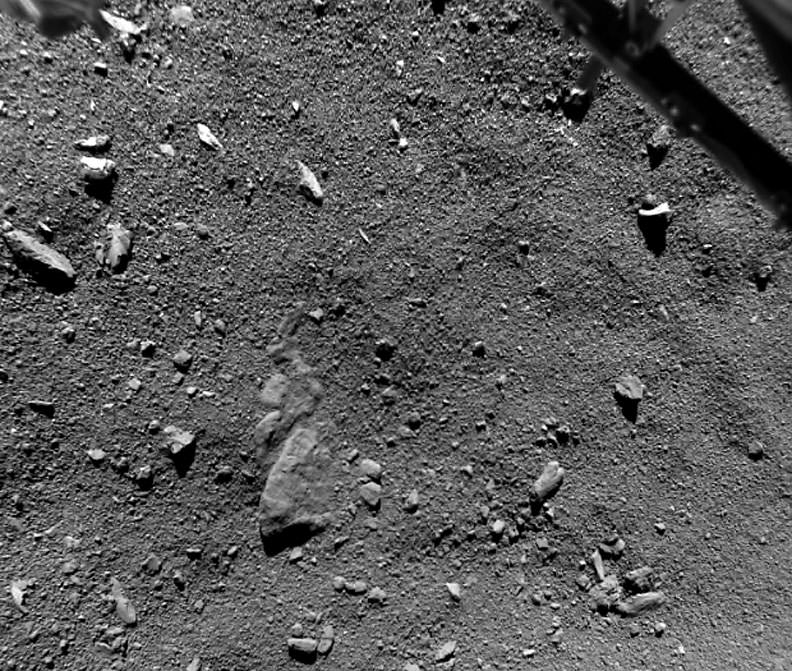
With just 12 days before Comet 67P/Churyumov-Gerasimenko reaches perihelion, we get a look at recent images and results released by the European Space Agency from the Philae lander along with spectacular 3D photos from Rosetta’s high resolution camera.
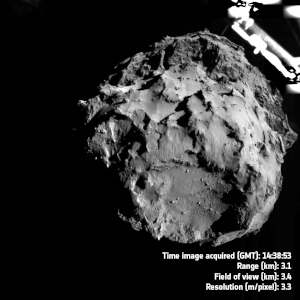
Credits: ESA/Rosetta/Philae/ROLIS/DLR
Remarkably, some 80% of the first science sequence was completed in the 64 hours before Philae fell into hibernation. Although unintentional, the failed landing attempt led to the unexpected bonus of getting data from two collection sites — the planned touchdown at Agilkia and its current precarious location at Abydos.
After first touching down, Philae was able to use its gas-sniffing Ptolemy and COSAC instruments to determine the makeup of the comet’s atmosphere and surface materials. COSAC analyzed samples that entered tubes at the bottom of the lander and found ice-poor dust grains that were rich in organic compounds containing carbon and nitrogen. It found 16 in all including methyl isocyanate, acetone, propionaldehyde and acetamide that had never been seen in comets before.
While you and I may not be familiar with some of these organics, their complexity hints that even in the deep cold and radiation-saturated no man’s land of outer space, a rich assortment of organic materials can evolve. Colliding with Earth during its early history, comets may have delivered chemicals essential for the evolution of life.
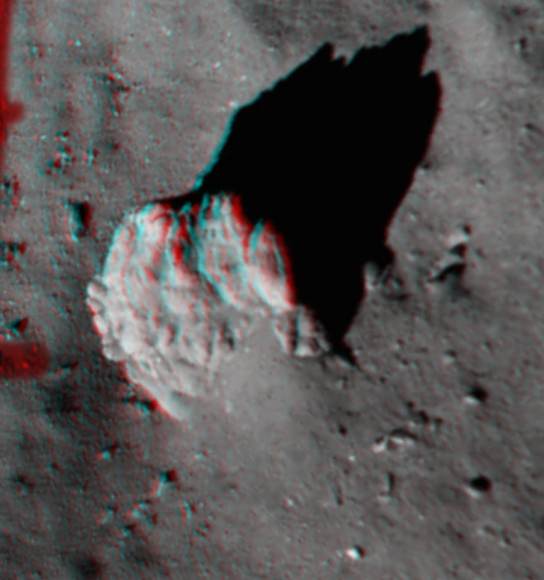
Ptolemy sampled the atmosphere entering tubes at the top of the lander and identified water vapor, carbon monoxide and carbon dioxide, along with smaller amounts of carbon-bearing organic compounds, including formaldehyde. Some of these juicy organic delights have long been thought to have played a role in life’s origins. Formaldehyde reacts with other commonly available materials to form complex sugars like ribose which forms the backbone of RNA and is related to the sugar deoxyribose, the “D” in DNA.
ROLIS (Rosetta Lander Imaging System) images taken shortly before the first touchdown revealed a surface of 3-foot-wide (meter-size) irregular-shaped blocks and coarse “soil” or regolith covered in “pebbles” 4-20 inches (10–50 cm) across as well as a mix of smaller debris.
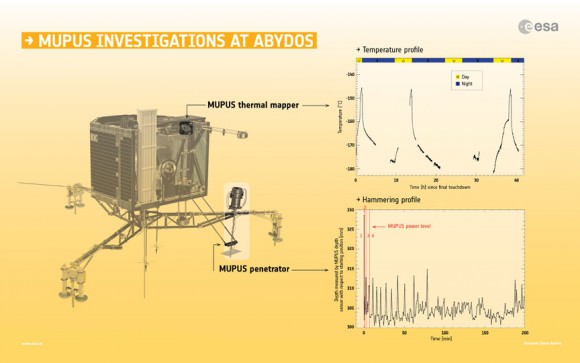
Agilkia’s regolith, the name given to the rocky soil of other planets, moons, comets and asteroids, is thought to extend to a depth of about 6 feet (2 meters) in places, but seems to be free from fine-grained dust deposits at the resolution of the images. The 16-foot-high boulder in the photo above has been heavily fractured by some type of erosional process, possibly a heating and cooling cycle that vaporized a portion of its ice. Dust from elsewhere on the comet has been transported to the boulder’s base. This appears to happen over much of 67P/C-G as jets shoot gas and dust into the coma, some of which then settles out across the comet’s surface.
Another suite of instruments called MUPUS used a penetrating “hammer” to reveal a thin layer of dust about an inch thick (~ 3 cm) overlying a much harder, compacted mixture of dust and ice at Abydos. The thermal sensor took the comet’s daily temperature which varies from a high around –229° F (–145ºC) to a nighttime low of about –292° F (–180ºC), in sync with the comet’s 12.4 hour day. The rate at which the temperature rises and falls also indicates a thin layer of dust rests atop a compacted dust-ice crust.
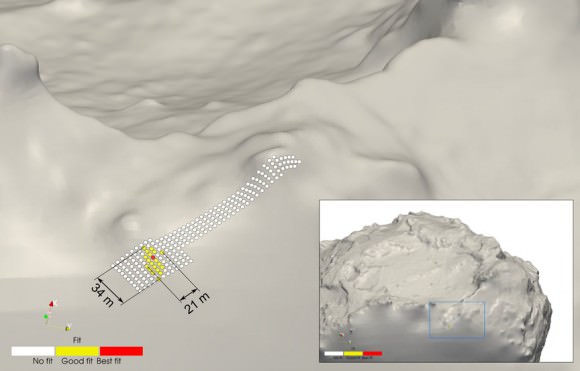
CONSERT, which passed radio waves through the nucleus between the lander and the orbiter, showed that the small lobe of the comet is a very loosely compacted mixture of dust and ice with a porosity of 75-85%, about that of lightly compacted snow. CONSERT was also used to help triangulate Philae’s location on the surface, nailing it down to an area just 69 x 112 feet ( 21 x 34 m) wide.
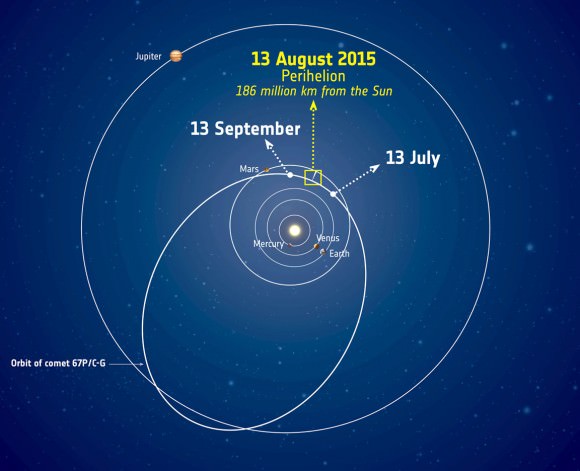
In fewer than two weeks, the comet will reach perihelion, its closest approach to the Sun at 116 million miles (186 million km), and the time when it will be most active. Rosetta will continue to monitor 67P C-G from a safe distance to lessen the chance an errant chunk of comet ice or dust might damage its instruments. Otherwise it’s business as usual. Activity will gradually decline after perihelion with Rosetta providing a ringside seat throughout. The best time for viewing the comet from Earth will be mid-month when the Moon is out of the morning sky. Watch for an article with maps and directions soon.
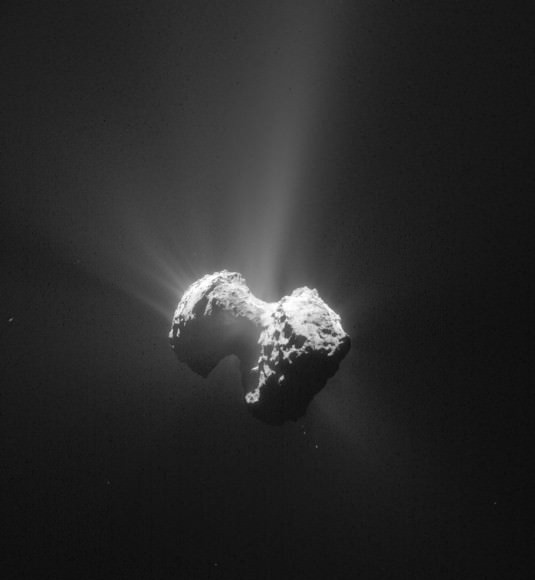
“With perihelion fast approaching, we are busy monitoring the comet’s activity from a safe distance and looking for any changes in the surface features, and we hope that Philae will be able to send us complementary reports from its location on the surface,” said Philae lander manager Stephan Ulamec.
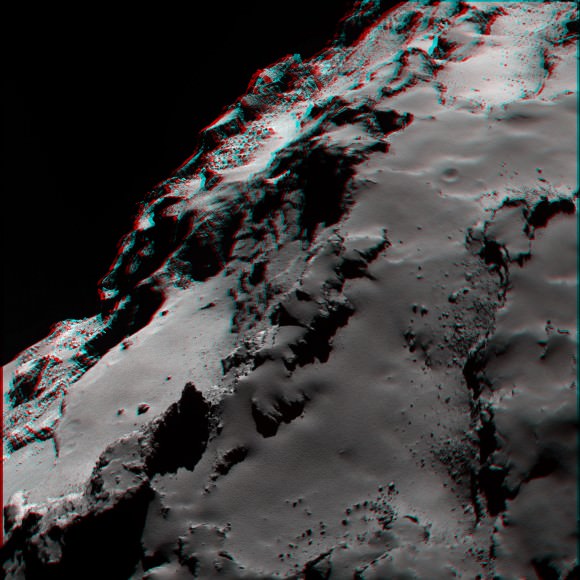
Credits: ESA/Rosetta/MPS for OSIRIS Team MPS/UPD/LAM/IAA/SSO/INTA/UPM/DASP/IDA
More about Philae’s findings can be found in the July 31 issue of Science. Before signing off, here are a few detailed, 3D images made with the high-resolution OSIRIS camera on Rosetta. Once you don a pair of red-blue glasses, click the photos for the high-res versions and get your mind blown.
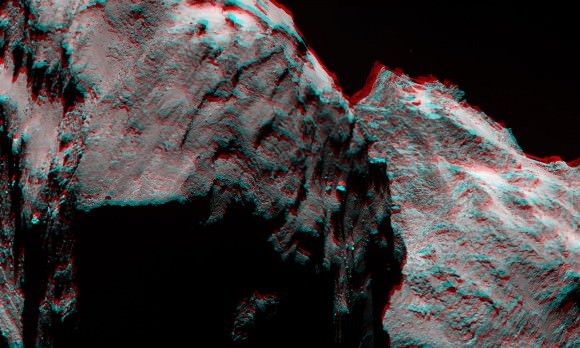
Credits: ESA/Rosetta/MPS for OSIRIS Team MPS/UPD/LAM/IAA/SSO/INTA/UPM/DASP/IDA
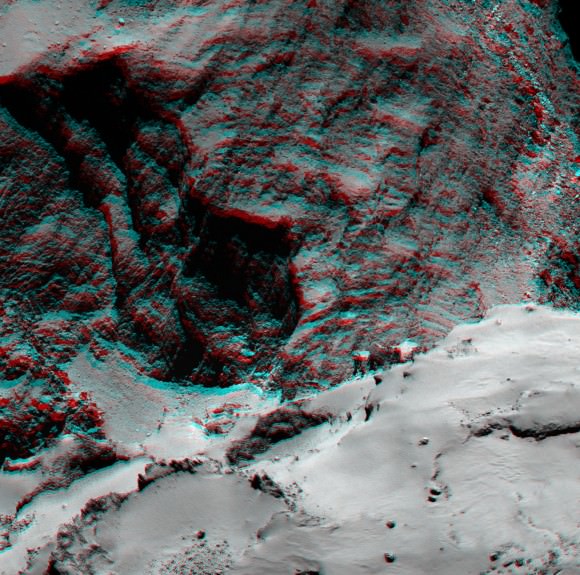
Credits: ESA/Rosetta/MPS for OSIRIS Team MPS/UPD/LAM/IAA/SSO/INTA/UPM/DASP/IDA
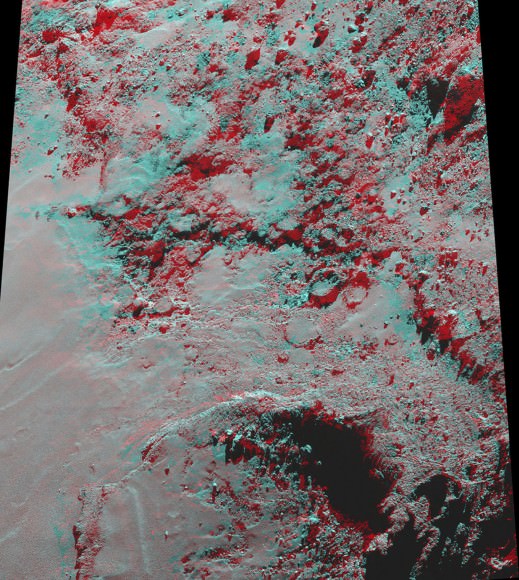
Weekly Space Hangout – June 26, 2015: Paul Sutter, CCAPP Visiting Fellow
Host: Fraser Cain (@fcain)
Special Guest: This week we welcome Paul Sutter, the CCAPP Visiting Fellow who works on the cosmic microwave background and large-scale structure.
Guests:
Jolene Creighton (@jolene723 / fromquarkstoquasars.com)
Brian Koberlein (@briankoberlein / briankoberlein.com)
Morgan Rehnberg (cosmicchatter.org / @MorganRehnberg )
Alessondra Springmann (@sondy)
Continue reading “Weekly Space Hangout – June 26, 2015: Paul Sutter, CCAPP Visiting Fellow”
Philae Wakes Up, Makes Contact!
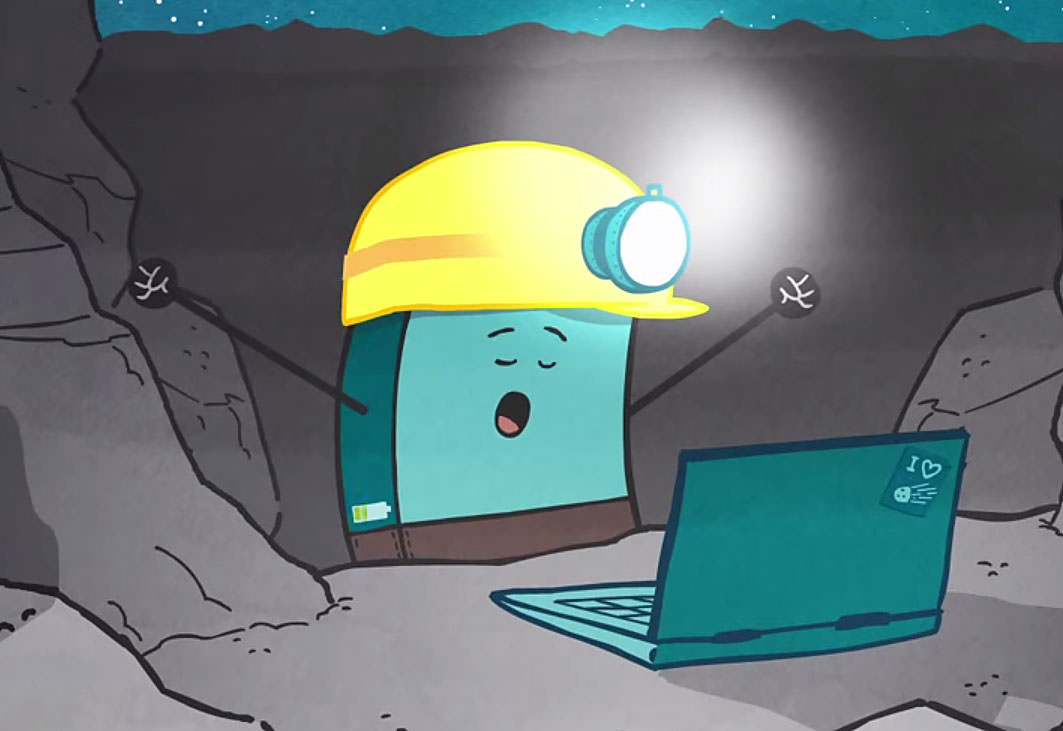
Fantastic news! Philae’s alive and kicking. The lander “spoke” with its team on ground via Rosetta for 85 seconds — its first contact since going into hibernation in November.
Signals were received at ESA’s European Space Operations Center in Darmstadt at 4:28 p.m. EDT yesterday June 13. The lander sent more than 300 data packets reporting on its condition as well as information about the comet.
“Philae is doing very well. It has an operating temperature of -35ºC (-31°F) and has 24 watts available,” said DLR Philae Project Manager Dr. Stephan Ulamec. “The lander is ready for operations.”
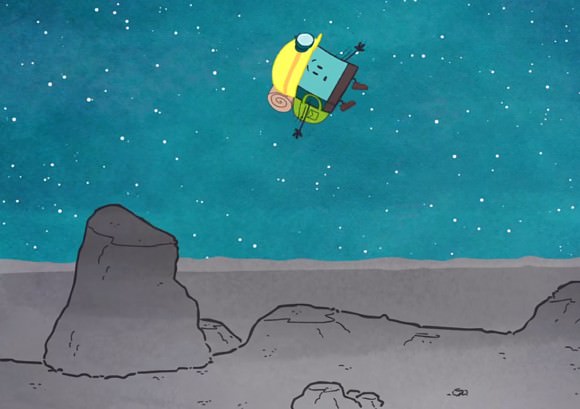
If coming out of hibernation isn’t surprising enough, it appears Philae has been awake for a while because it included historical data along with its current status in those packets. There are still more than 8000 data packets in Philae’s mass memory which will give the mission scientists information on what happened to the lander in the past few days on Comet 67P/C-G.
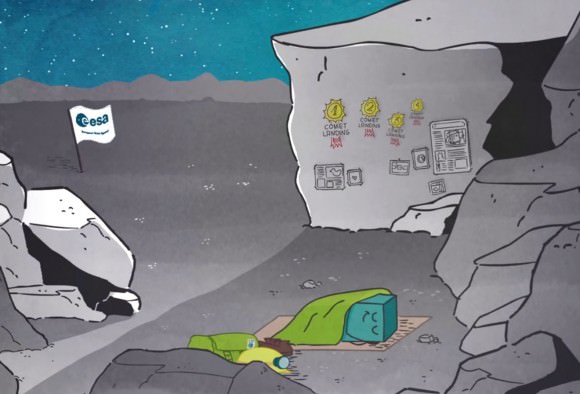
Philae shut down on November 15 after about 60 hours of operation on the comet after landing at the base of a steep cliff in a shaded area that prevented the solar panels from charging its batteries. Since March 12, the Rosetta lander has been “listening” for a signal from the lost lander.

Throughout, mission scientists remained hopeful that the comet’s changing orientation and increase in the intensity of sunlight as it approached perihelion would eventually power up the little lander. Incredible that it really happened.
Yesterday, we looked at the many attempts to find Philae. A day later it’s found us!
Both amateurs and professional astronomers across the world are in constant contact sharing observations of Comet 67P/C-G and news from the Rosetta mission. Klim Churyumov, co-discoverer of the comet, had this to say upon hearing the news of Philae’s awakening:
“Hurrah! Hurrah! Hurrah! Landing probe Philae awake! Everybody, please accept my sincere congratulations! It happened on 13 June 2015 in the day of birthday of my mother – Antonina Mikhailovna (108 years have passed since the day of her birth). And I’m starting from 13 November 2014 to this day, every morning pronounced a short prayer: “Lord, please wake Philae and support Rosetta”. God and the Professional Navigators woke Philae! It is fantastic! All the best! – Klim Churyumov.
How poignant Philae awoke on Klim’s mother’s birthday!
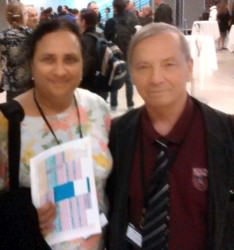
Churyumov made his statement on the Pro-Am Collaborative Astronomy (PACA) site devoted to pro-amateur collaboration during comet observing campaigns. I encourage you to check out the group and participate by submitting your own observations of Comet 67P as it brightens this summer and early fall.
* UPDATE: In the coming days, the mission teams will reestablish contact with Philae and increase the amount of time it can “talk” with the lander. Once regular contact is established, science observations can begin again. Slowly. One instrument at a time.
The first instruments activated, those measuring temperature, magnetic fields and electrical conductivity on the comet, make small demands on Philae’s power. Slightly more power-hungry operations like picture taking and radio ranging will follow. Using the images and new data, scientists should be able to pinpoint the lander’s location.
After these steps, mission engineers will attempt to recharge the probe’s drained batteries to fire up its ovens (used to heat samples to determine their composition) and run the drill to collect fresh material.
Here’s a cool link to see LIVE telemetry from Philae.
Have We Found Rosetta’s Lost Philae Lander?
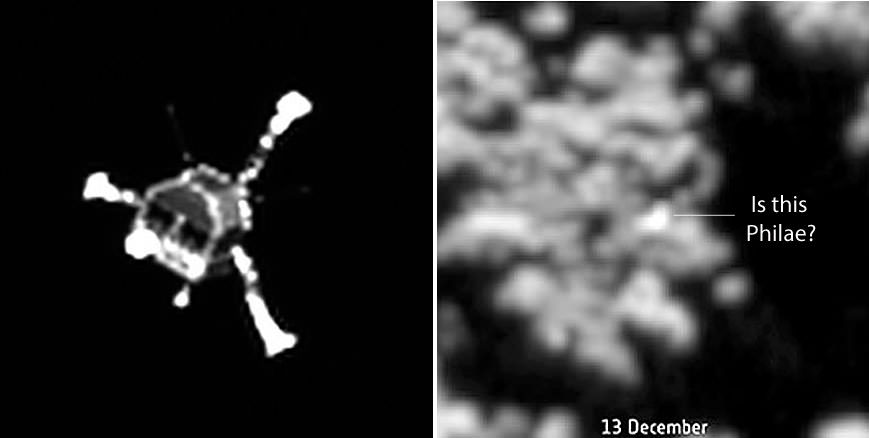
It’s only a bright dot in a landscape of crenulated rocks, but the Rosetta team thinks it might be Philae, the little comet lander lost since November.
The Rosetta and Philae teams have worked tirelessly to search for the lander, piecing together clues of its location after a series of unfortunate events during its planned landing on the surface of Comet 67P/Churyumov-Gerasimenko last November 12.
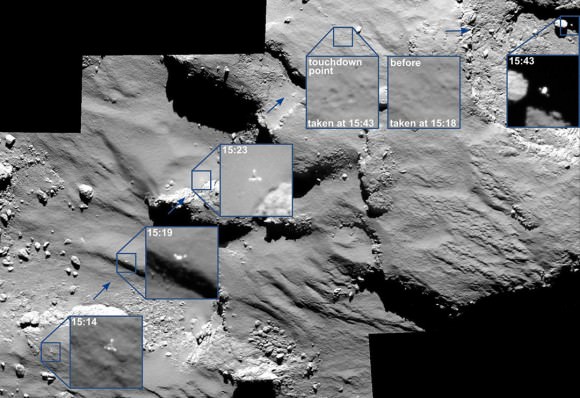
Philae first touched down at the Agilkia landing site that day, but the harpoons that were intended to anchor it to the surface failed to work, and the ice screws alone weren’t enough to do the job. The lander bounced after touchdown and sailed above the comet’s nucleus for two hours before finally settling down at a site called Abydos a kilometer from its intended landing site.
No one yet knows exactly where Philae is, but an all-out search has finally turned up a possible candidate.
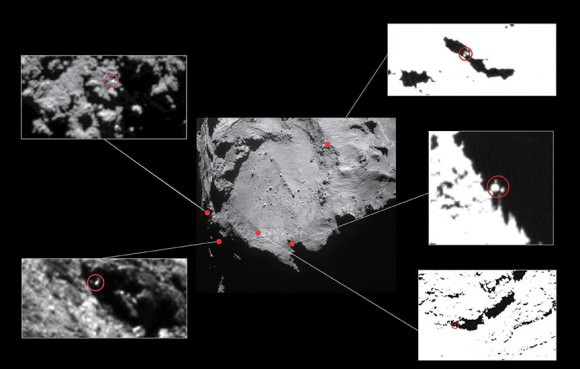
Rosetta’s navigation and high-resolution cameras identified the first landing site and also took several pictures of Philae as it traveled above the comet before coming down for a final landing. Magnetic field measurements taken by an instrument on the lander itself also helped establish its location and orientation during flight and touchdown. The lander is thought to be in rough terrain perched up against a cliff and mostly in shadow.
High resolution images of the possible landing zone were taken by Rosetta back in December when it was about 11 miles (18 km) from the comet’s surface. At this distance, the OSIRIS narrow-angle camera has a resolution of 13.4 inches (34 cm) per pixel. The body of Philae is just 39 inches (1-meter) across, while its three thin legs extend out by up to 4.6 feet (1.4-meters) from its center. In other words, Philae’s just a few pixels across — a tiny target but within reach of the camera’s eye.
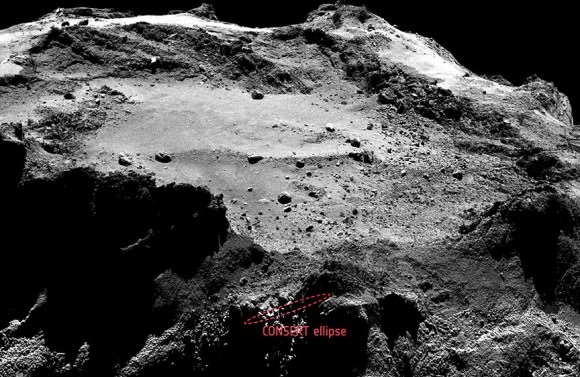
The candidates in the photo above are “all over the place.” To narrow down the location, the Rosetta team used radio signals sent between Philae and Rosetta as part of the COmet Nucleus Sounding Experiment or CONSERT after the final touchdown. According to Emily Baldwin’s recent posting on the Rosetta site:
“Combining data on the signal travel time between the two spacecraft with the known trajectory of Rosetta and the current best shape model for the comet, the CONSERT team have been able to establish the location of Philae to within an ellipse roughly 50 x 525 feet (16 x 160 meters) in size, just outside the rim of the Hatmehit depression.”
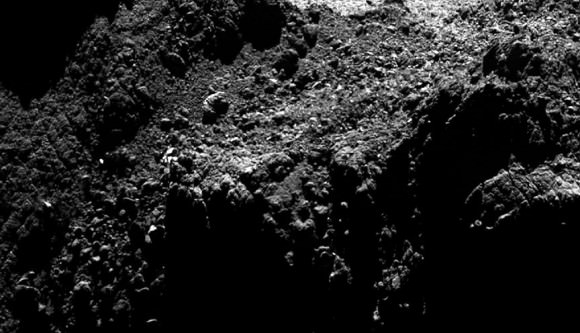
Credits: ESA/Rosetta/MPS for OSIRIS Team MPS/UPD/LAM/IAA/SSO/INTA/UPM/DASP/IDA
So what can we see there? Zooming in closer, a number of glints or bright spots appear, and they change depending on the viewing angle. But among those glints, one might be Philae. What mission scientists examined images of the area under the same lighting conditions before Philae landed and then put them side by side with those taken after November 12. That way any transient glints could be eliminated, leaving what’s left as a potential candidate.
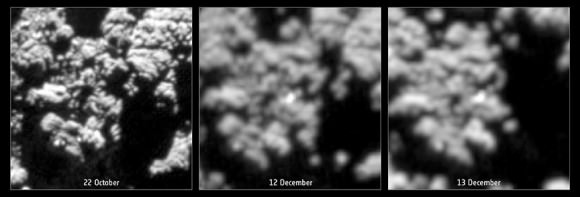
Credits: ESA/Rosetta/MPS for OSIRIS Team MPS/UPD/LAM/IAA/SSO/INTA/UPM/DASP/IDA
In photos taken on December 12 and 13, a bright spot is seen that didn’t appear in the earlier photos. Might this be Philae? It’s possible and the best candidate yet. But it may also be a new physical feature that developed between November and December. Comet surfaces are forever changing as sunlight sublimates ice both on and beneath the surface
For now, we still can’t be sure if we’ve found Philae. Higher resolution pictures will be required as will patience. The comet’s too close to the Sun right now and too active. Rubble flying off the nucleus could damage Rosetta’s instruments. Mission scientists will have to wait until well after the comet’s August perihelion (closest approach to the Sun) for a closer look.
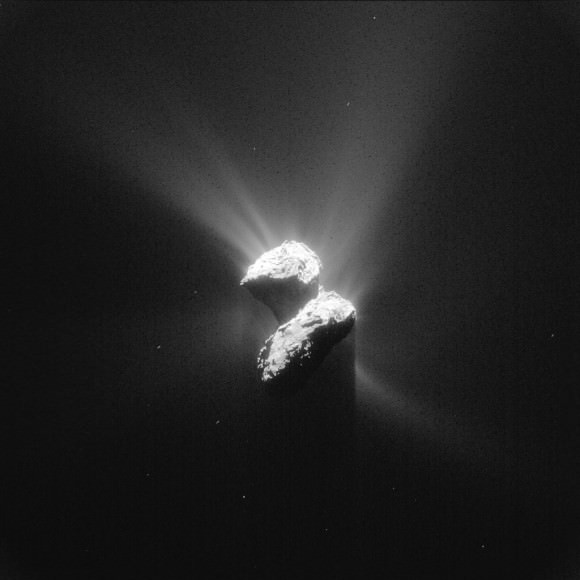
Meanwhile, mission teams remain hopeful that with increasing sunlight at the comet this summer, Philae’s solar panels will recharge its batteries and the three-legged lander will wake up and resume science studies. Three attempts have been made to contact Philae this spring and more will be made but so far, we’ve not heard a peep.
For the time being, Philae’s like that lost child in a shopping mall. The search party’s been dispatched, clues have been found and it’s only a matter of time before we see her smiling face again.


